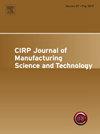低刚度薄壁件变形机理及控制研究进展
IF 5.4
2区 工程技术
Q2 ENGINEERING, MANUFACTURING
CIRP Journal of Manufacturing Science and Technology
Pub Date : 2025-06-04
DOI:10.1016/j.cirpj.2025.05.007
引用次数: 0
摘要
薄壁部件以其轻量化和高性能的特点而闻名,在航空航天、雷达和运输等行业中具有重要的战略意义。然而,由于其固有的低刚度-包括剪切,弯曲和扭转刚度-这些部件在加工过程中极易变形。这种变形会对零件的几何完整性和加工精度产生不利影响,包括尺寸精度、形状精度和位置精度。因此,控制薄壁构件的变形已成为近年来的一个重要研究热点。本文综述了薄壁零件加工变形类型、变形机理和变形控制策略的最新进展,旨在为读者提供实现薄壁零件加工高效率和高精度的动态方法。第一部分概述了薄壁零件的定义、分类和影响加工精度的因素。第二部分讨论了薄壁零件变形背后的机理,这是多种因素共同作用的结果,包括切削力、切削温度、残余应力、夹具和加工颤振引起的变形。第三部分回顾了几种控制变形的方法,包括自适应加工和误差补偿,稳定性叶瓣图和颤振抑制,变形预测和控制,以及能量场辅助加工。这些方法可以在加工前、加工中和加工后控制和防止薄壁部件变形。最后,总结了薄壁零件加工目前面临的挑战,并展望了未来的发展趋势。本文介绍的研究内容和方法,包括理论分析、实验验证和仿真分析,为研究人员提供了清晰的背景和研究路线图,有助于在未来的研究中对薄壁零件高精度加工技术的探索和改进。本文章由计算机程序翻译,如有差异,请以英文原文为准。
A review of the deformation mechanism and control of low stiffness thin-walled parts
Thin-walled components, known for their lightweight and high-performance characteristics, hold significant strategic importance in industries such as aerospace, radar, and transportation. However, due to their inherently low stiffness—encompassing shear, bending, and torsional stiffness—these components are highly susceptible to deformation during machining. This deformation can adversely affect the geometric integrity and machining precision of the component, including dimensional accuracy, shape accuracy, and positional accuracy. Controlling the deformation of thin-walled components has thus become a critical research focus in recent years. This paper reviews the latest developments in the types of machining deformation, deformation mechanisms, and deformation control strategies for thin-walled components, aiming to equip readers with dynamic approaches for achieving high efficiency and precision in thin-walled component machining. The first section provides an overview of the definition, classification, and factors affecting the machining accuracy of thin-walled components. The second section discusses the mechanisms behind the deformation of thin-walled components, which result from a combination of multiple factors, including deformation caused by cutting forces, cutting temperature, residual stress, fixturing, and machining chatter. The third section reviews several methods for controlling deformation, including adaptive machining and error compensation, stability lobe diagrams and chatter suppression, deformation prediction and control, and energy field-assisted machining. These methods allow for the control and prevention of thin-walled component deformation before, during, and after machining. Finally, the paper summarizes the current challenges in thin-walled component machining and outlines future development trends. The research content and methods introduced in this paper, including theoretical analysis, experimental validation, and simulation analysis, provide researchers with a clear background and research roadmap, contributing to the exploration and improvement of high-precision machining techniques for thin-walled components in future research.
求助全文
通过发布文献求助,成功后即可免费获取论文全文。
去求助
来源期刊

CIRP Journal of Manufacturing Science and Technology
Engineering-Industrial and Manufacturing Engineering
CiteScore
9.10
自引率
6.20%
发文量
166
审稿时长
63 days
期刊介绍:
The CIRP Journal of Manufacturing Science and Technology (CIRP-JMST) publishes fundamental papers on manufacturing processes, production equipment and automation, product design, manufacturing systems and production organisations up to the level of the production networks, including all the related technical, human and economic factors. Preference is given to contributions describing research results whose feasibility has been demonstrated either in a laboratory or in the industrial praxis. Case studies and review papers on specific issues in manufacturing science and technology are equally encouraged.
 求助内容:
求助内容: 应助结果提醒方式:
应助结果提醒方式:


